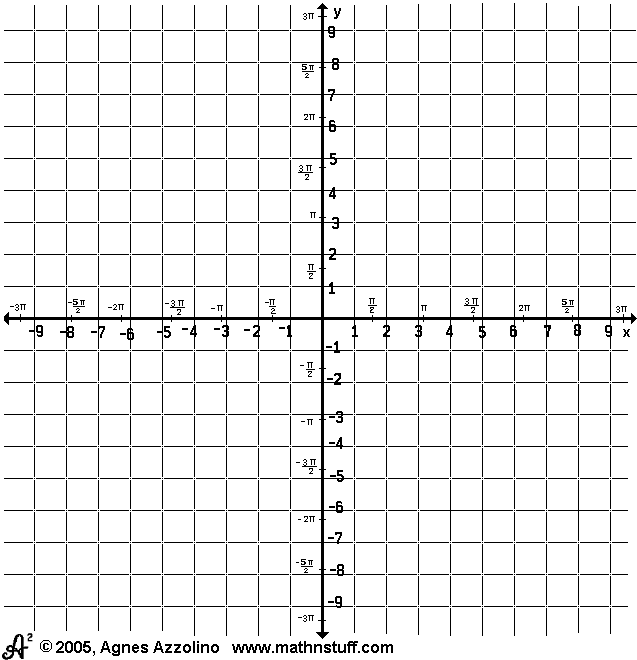-
Exploring Functions
through the Use of Manipulatives
- © '94, '95, '97, '98, '00, '04, '12 Agnes Azzolino (asquared@mathnstuff.com)
-

- 1) PRETEST Answer these now,
- mentally if you wish.
- 1. Sketch the graphs of y = 0 and x = 0.
- 2. Write the equation for this function.
- 3. What effect will the k have in the function y = f(x) + k.
- 4. For what numbers is the square of the number greater than on more than the number?
- 5. Sketch y = x · sin(x)
- HOMEWORK
- 6. Before graphing y = x·ex, predict what the
graph should look like. Mentally rehearse an explanation, addressed to
another student, which explains or justifies the graph of the function.
-
- 2) The Pretest focuses on the content of this session.
- It's what
the session is about. Please:
- 1. Complete the pretest, mentally or in some other manner.
- 2. Introduce yourselves to each other and find a partner
- 3. Discuss the pretest with your partner.
- [Discuss this with your partner (DTWYP).]
-
- 3) The materials you will be using today must be returned.
- As you leave, please return your materials. If you leave
early, please return your materials.
- At the end of the session, you will receive a copy of the
text of most of the transparencies and a large coordinate plane.
-
- 4) Please:
- a) Leave the printed coordinate plane in the pocket.
- b) Examine and handle the other things in the plastic pocket.
- c) Consider how they might be used in mathematics classes.
- d) Discuss this with your partner (DTWYP).
-
- 5) Consider each question and DTWYP.
- What functions have been included?
- identity, reciprocal, opposite, absolute value, square,
- dilations of the absolute value
- What things have not been included but might be?
- square root, exponential-log, sine-cosine, half-plane, reciprocal,
- half-circles, tangent- cotangent, secant-cosecant
- What kinds of things might one do with these manipulatives?
-
- Identify (through point-plotting),
- Graph,
- Sketch,
- Find the inverse function,
- Estimate the slope,
- Describe,
- Discuss,
- Write an expression,
- Solve,
- Predict the graph of,
- Explain behavior,
- Show functions with your hands and body.
-
- 6) Graph by placement on the coordinate plane. DTWYP.
- a. the identity function
- b. the opposite function
- c. the reciprocal function
- d.

- e.
 - f.

- g.
 - h.

- i. y = (x - 4)²
- j. y = - (x - 2)² + 3
- k. x = y²
- m.

- n. the distance between a number and 3
-
- 7) Sketch each of the above on paper to debrief and DTWYP.
- Debriefing can not be emphasized enough.
- Do not leave students
"thinking in the concrete."
(www.mathnstuff.com/papers/langu/page9.htm)
- Force a summary in the more abstract
written
activity of sketching and writing notes, and discussing.
(www.mathnstuff.com/papers/langu/page6.htm)
-
- Use of the Slopemeter
- Be crude with your slope-generated curve.
- [Repeat the slope: Don't use a ruler. Think m=3/4 is also -3/(-4), 6/8.]
-
- 8) Solve the statements by graphing 2 functions on the same plane:
- [a.] |x - 3| = 4
- [b.] |x - 3| = 0
- [c.] |x - 3| = -4
- [d.] |x - 3| = |x + 2|
- [e.] |x - 3| = ( x + 2 )² + 1
-
- 9) Use the identity function to compare, describe, then discuss.
- A) Graph the identify function and a specific function
- on the same coordinate plane,
- B) Compare these two functions.
- C) Use these thoughts to describe the function. DTWYP.
-
- 10) We are not through for the day but we have finished with the manipulatives.
- Please place your materials back in the pockets.
- Defrief by listing some ideas we considered.
- DTWYP as the manipulatives are collected.
-
- 11) Before we continue, I'd like to answer any quick Questions.
-
- 12)
Math "Exercises"(www.mathnstuff.com/papers/langu/exerc.htm)
- a) Use your body, arms, and hands to represent the graph of:
- 1. y = 0
- 2. x = 0
- 3. y = x
- 4. y = -x
- 5. y = x²
- 6. x = y²
- 7. y = -2x²
- 8. y = - |x|
- 9. y = 2|x|
- 10. y = |x| - 2
- 11. y = |x| + 2
- 12. y = 1/x
- b) Please be seated.
-
-
- 13) Dilation by a nonconstant function is wonderful.
- Use the composition of functions to sketch an unknown function.
- a) What does a cubic look like and why? DTWYP.
- y= x3 = x(x²)
- b) What does a rational function look like?
- y = (x +3)(x-4)/(x-2)
- c) Why does the tangent look that way?
- Tangent to the unit circle,
- y = tan x = (sin x)/(cos x)
- d) What are envelope functions?
- How do they look?
- y = ex(sin x)
- Consider the graphs of
- sin(x), 4sin(x), x · sin(x),
- x² · sin(x), ln(x) · sin(x),
- ex · sin(x)
- Other toys:
-
Sine Law- Ambiguous Case & Sketchpad trig stuff,
-
Polynomial &
Rational Function through Dilation
- Spreadsheets for Dialations Creating
Polynomials &
Rationals
-
-
- 14) Words to the Wise and Wrap Up.
Words to the Wise
- Manipulatives must be available in order to be used.
- Expect breakage and loss of material.
- Plan free play before work.
- Start with short activities and build on these.
- Always close with an abstraction activity.
- Self-evaluate after each lesson.
-
-
- 15) We must teach our students to:
- Play
- Experiment
- Suppose
- Create
- Sketch
- Draw
- Write Notes
- Write Sentences
- Debrief
- Dream
- Think and
- Visualize
-
- You've sampled the power of the manipulative and
seen it used as it should be in conjunction with introspection, communication,
and technology. I hope you learned or relearned a little math, might consider
using a strategy demonstrated here today, and had a little fun. Thank you for coming.
Math Class Languages (www.mathnstuff.com/papers/langu/page4.htm)
Mother Tongue Other Tongue(s)
-
VERBAL
- formal spoken mathematics
- informal spoken mathematics
- spoken symbol
- symbol speak
- calculatoreze/computereze
- web speak
| -
WRITTEN
- written word
- written symbol
- semisymbolic
- calculator symbol
|
-
PICTORIAL
- picture
- numeral
- graph
- nonverbal body language
|
-
CONCRETE
- object
- model
- manipulative/token
|
 The above graphic may be found at www.mathnstuff.com/gif/mciplane.gif
The above graphic may be found at www.mathnstuff.com/gif/mciplane.gif
|



